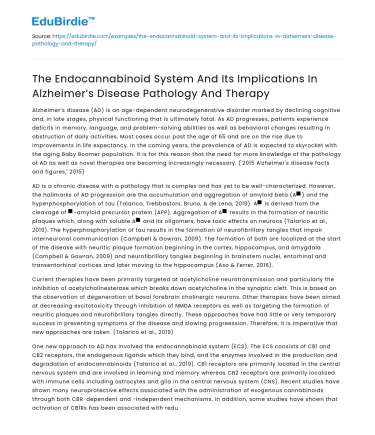Alzheimer’s disease (AD) is an age-dependent neurodegenerative disorder marked by declining cognitive and, in late stages, physical functioning that is ultimately fatal. As AD progresses, patients experience deficits in memory, language, and problem-solving abilities as well as behavioral changes resulting in obstruction of daily activities. Most cases occur past the age of 65 and are on the rise due to improvements in life expectancy. In the coming years, the prevalence of AD is expected to skyrocket with the aging Baby Boomer population. It is for this reason that the need for more knowledge of the pathology of AD as well as novel therapies are becoming increasingly necessary. ('2015 Alzheimer's disease facts and figures,' 2015)
AD is a chronic disease with a pathology that is complex and has yet to be well-characterized. However, the hallmarks of AD progression are the accumulation and aggregation of amyloid beta (Aβ) and the hyperphosphorylation of tau (Talarico, Trebbastoni, Bruno, & de Lena, 2019). Aβ is derived from the cleavage of β-amyloid precursor protein (APP). Aggregation of Aβ results in the formation of neuritic plaques which, along with soluble Aβ and its oligomers, have toxic effects on neurons (Talarico et al., 2019). The hyperphosphorylation of tau results in the formation of neurofibrillary tangles that impair interneuronal communication (Campbell & Gowran, 2009). The formation of both are localized at the start of the disease with neuritic plaque formation beginning in the cortex, hippocampus, and amygdala (Campbell & Gowran, 2009) and neurofibrillary tangles beginning in brainstem nuclei, entorhinal and transentorhinal cortices and later moving to the hippocampus (Aso & Ferrer, 2016).
Save your time!
We can take care of your essay
- Proper editing and formatting
- Free revision, title page, and bibliography
- Flexible prices and money-back guarantee
Current therapies have been primarily targeted at acetylcholine neurotransmission and particularly the inhibition of acetylcholinesterase which breaks down acetylcholine in the synaptic cleft. This is based on the observation of degeneration of basal forebrain cholinergic neurons. Other therapies have been aimed at decreasing excitotoxicity through inhibition of NMDA receptors as well as targeting the formation of neuritic plaques and neurofibrillary tangles directly. These approaches have had little or very temporary success in preventing symptoms of the disease and slowing progreession. Therefore, it is imperative that new approaches are taken. (Talarico et al., 2019)
One new approach to AD has involved the endocannabinoid system (ECS). The ECS consists of CB1 and CB2 receptors, the endogenous ligands which they bind, and the enzymes involved in the production and degradation of endocannabinoids (Talarico et al., 2019). CB1 receptors are primarily located in the central nervous system and are involved in learning and memory whereas CB2 receptors are primarily localized with immune cells including astrocytes and glia in the central nervous system (CNS). Recent studies have shown many neuroprotective effects associated with the administration of exogenous cannabinoids through both CBR-dependent and -independent mechanisms. In addition, some studies have shown that activation of CB1Rs has been associated with reduced cognitive decline. This has brought obvious attention to the ECS as a potential target for future AD therapies. (Patricio-Martínez et al., 2019)
In this paper, I will review the efficacy of therapies involving CB1 and CB2 receptors primarily in mouse and rat models. This is primarily due to the fact that human studies are much less prevalent and tend to be less conclusive due to confounding variables. Mouse and rat models provide cheaper, more efficient, and more precise ways to manipulate and control variables allowing for better and more ample data. Through the coverage of studies involving drugs and genetic manipulations targeting CB1 and CB2 receptors, I will explore how the ECS may be implicated in AD as well as how it can be used to alleviate its symptoms.
Although these topics were briefly discussed in the introduction, it is important to take a closer, more in-depth look at the pathology of AD and further introduce the purpose and make-up of the ECS. This will provide a better understanding of where the AD progression and the ECS overlap and how we can manipulate one to effect the other.
As discussed previously in the introduction, the hallmarks of AD are the presence of Aβ senile plaques due to the aggregation of Aβ monomers and neurofibrillary tangles composed of hyperphosphorylated and truncated forms of tau protein (Talarico et al., 2019). Other factors key to the progression of AD are inflammation, oxidative stress, decreased mitochondrial function, and improper functioning of degradation pathways.
Neuroinflammation associated with AD is commonly thought to be brought on by Aβ aggregation as the inflammatory response works to break down and/or remove the senile plaques. This process is characterized by microglial activation, astrocyte reactivity, and the presence of inflammatory mediators like cytokines. Microglial activation is a key part of this response as these cells work to remove senile plaques. It is important to note that there are two main types of microglia: one that is detrimental (M1) and one that is beneficial (M2). This makes the inflammatory response a two-edged sword: not all good or bad. Astrocytes also play a role as they internalize Aβ, release inflammatory mediators, (Aso & Ferrer, 2016) and increase expression of inducible nitric oxide synthase (iNOS) which produces NO, a reactive nitrogen species that can have toxic effects (Patricio-Martínez et al., 2019). Another thing that complicates the effects of the inflammatory response is the stage of AD and the length of inflammation. In early stages of the disease, the inflammatory response is favorable as it removes accumulated Aβ. However, chronic inflammation triggered by continuous Aβ aggregation can cause more harm than good due to the system’s prolonged exposure to inflammatory mediators which can have toxic effects. Therefore, in determining the effects of neuroinflammation, it is important to note the stage of the disease, the length of inflammation, the specific brain region involved and which type of microglia is most prevalent.






 Stuck on your essay?
Stuck on your essay?

